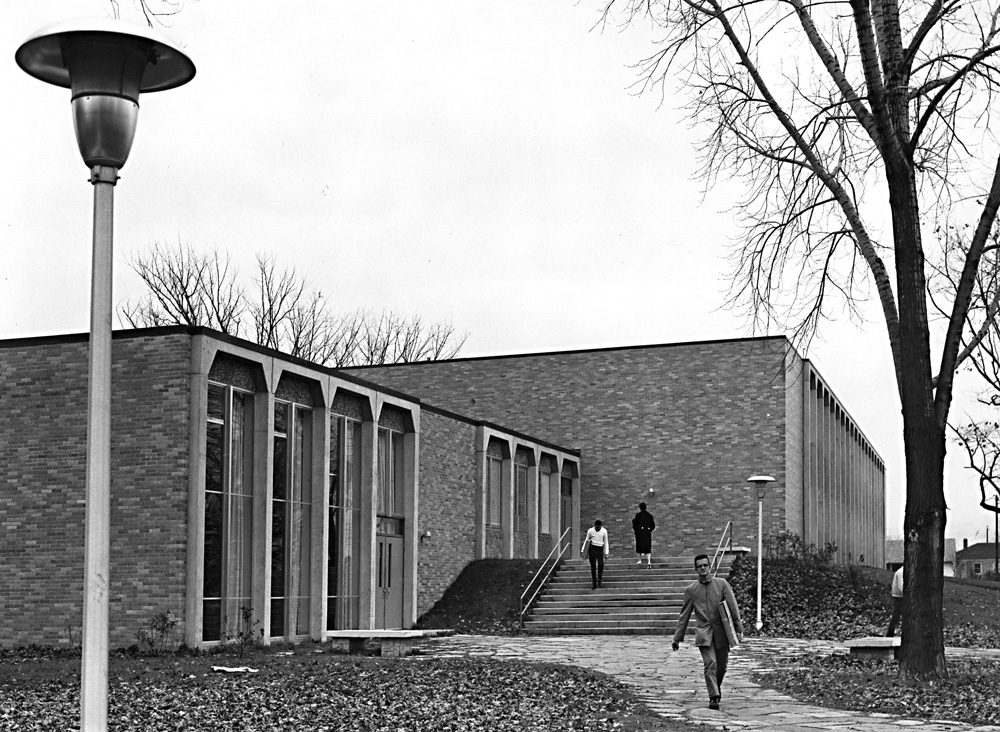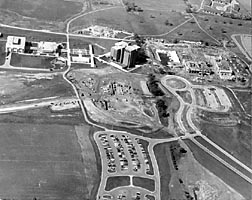Chapter Eight: 1974—1975
“On this occasion, it's my one wish and my one hope that we will continue to see the growth, development and progress in the next ten years that has taken place in the last ten years under the leadership of Chancellor Weidner, the faculty and the citizens of this community.”
- Former Gov. Warren B. Knowles, Sept. 19, 1975
Ground was broken November 3, 1967. ... Construction began soon afterward, and so began nine years of dirty shoes on weekends for me. And I've enjoyed every minute of it.”
- Chancellor Edward Weidner, Sept. 19, 1975
The University was celebrating its first 10 years.
Before 360 guests gathered for after-dinner festivities in the lobby of the Community Sciences Building, Weidner presented the Chancellor's Award of Merit to Warren Knowles, who in his first term of office had signed the legislation creating UW-Green Bay and UW-Parkside.
Knowles was visiting the University for the first time since the opening convocation in 1969. Accepting his award, he described UW-Green Bay as “a dream that has become a reality.” He noted that the Green Bay campus, through a decade of turmoil at other collegiate institutions, had never been the scene of a “significant problem” arising from student protest.
Echoing other observers of the student scene, Knowles said, “In spite of the fact that we did go through this turbulent period, I think we're now moving forward into a period where again education has reached the point of normality, where boys and girls recognize the importance of an education to provide support for their families, provide support for themselves, and continue to develop a better society in which to live.”

Deckner Avenue building
Weidner provided the narration for a slide-show review of campus development, emphasizing the achievements of the recent past. The list was impressive.
Full occupancy of the College of Community Sciences and College of Creative Communication buildings during the previous year had doubled the capacity of the campus. And the brass fanfare that heralded the opening of the University Theatre had ushered in, as well, a new era of awareness of the University's role in the cultural life of the community.
Events marking the dedication of the arts complex included an opening address by Michael Whitney Straight, deputy chairman of the National Endowment for the Arts, a Green Bay Symphony concert, a Milwaukee Skylight Theatre production of Threepenny Opera, a Günter Grass play staged by German language students, and three performances of William Inge's Come Back, Little Sheba by a student and faculty cast. A month later the stage was filled with “wandering minstrels” returned to a permanent home. After five years of performing in high school auditoriums, churches, the campus lecture hall and the music-drama room at the UW Center, University bands and choral ensembles presented their first concert in the new facility.
On a Saturday in May 1974, 2,500 high school musicians invaded classrooms, studios and auditoriums in the complex, vying for honors in the first of the state solo-ensemble festivals that would become an annual event on the campus. In June, a statewide UW-Extension art education program moved permanently to UW-Green Bay from the two-year center in Wausau. More than 500 junior and senior high school students explored new and familiar art media during two one-week sessions.
In August—thanks to new facilities and an expanded program—Tom Birmingham could report that attendance at University-sponsored lectures and performances had doubled since the opening of the campus: from 10,000 in 1969-70 to 21,000 in 1973-74. And to the well-equipped, 487-seat performance hall, he promised, the season ahead would bring a full slate of visiting artists of the caliber of those already booked: Jessica Tandy and Hume Cronyn in The Many Faces of Love, and the Bella Lewitsky dance company.
With all the amenities of a proper theater in place—scene and costume shops, dance studio, professional lighting equipment and a 39-by-112 foot stage—performing arts faculty members produced the first campus musical in 1975. Kismet, drenched in the melodies of Borodin, was rehearsed during the January interim and staged for seven performances in February.
Three of the four academic clusters projected in the campus master plan were now complete. But Weidner was not about to be deprived of construction sites to visit. Even as students and faculty moved into new classrooms and laboratories in the fall, architects in the Somerville Associates firm were writing specifications for the Phoenix Sports Center. It would be the fifth major construction project, and the first designed by a local firm. Weidner had won further commitments from the state for a student union and a stores and maintenance building. By spring, all three buildings would be rising on the campus.
At the 10-year milestone for UW-Green Bay, merger was an accomplished fact. Approved by the Legislature in May 1974 after 17 months of political maneuvering, the implementation bill provided a single statutory charter for the system of 13 universities, 14 freshman-sophomore centers and University Extension. UW-Madison and UW-Milwaukee would continue to be the only two doctoral campuses, with Madison the comprehensive research and graduate institution. Revised mission statements retained most of the graduate programs existing or planned at the former Wisconsin State University campuses. And UW-Green Bay and UW-Stout kept the designation they had sought as special mission institutions.

UW-Green Bay campus, 1974-75
For UW-Green Bay, the legislation affirmed an approach to undergraduate and graduate education that would continue to set the campus apart from other UW units. The special mission statement read in part:
“The University should offer a focused, institutionwide academic program that is substantially unique in both its goals and organization, emphasizing interdisciplinary, problem-centered study of man in the environment. ... The University should offer programs leading to professional certification or equivalent in areas clearly associated with its mission. ... The University should provide basic graduate education which grows clearly and directly from the unique organization and goals of the undergraduate program.”
Ten years into its official history, UW-Green Bay was also celebrating the most recent honors bestowed on Chancellor Weidner.
In May 1975 Weidner traveled to Sweden to receive the first honorary doctorate from the University of Linköping. The degree was conferred during ceremonies marking the formal inauguration of the University, established in the late 1960s. It recognized Weidner's contributions to developing the faculty in arts and sciences. Back home again, Weidner received the Outstanding Achievement Award of the University of Minnesota, given annually “in recognition of former students who have attained distinction and honor in their fields.” One of Weidner's most significant honors was his appointment a year earlier to the governing council of United Nations University, a new world institution of postgraduate study and research. Weidner would serve for six years as the only American on the Council.
The end of the first decade also brought vacancies in key positions and another reshaping of the administration.
Robert Maier, vice chancellor since 1969, resigned from his post to return to the faculty. John Beaton, dean of the colleges, moved to an administrative job at the University of Maryland. On recommendation of a faculty committee, Weidner created a new administrative unit, the Office of Academic Affairs, and named Professor John Reed, a plant ecologist, as its dean. Reporting to Reed would be six senior administrators. They included Professors Harold J. (Jack) Day, named director of the Institute for Research on Environmental Change; Martin Greenberg, director of graduate studies; Walter Herrscher, director of undergraduate studies; and Forrest Armstrong, associate dean. Marge Engelman, director of outreach, and Ronald Dhuey, registrar, completed the group. German Professor W. Werner Prange was appointed vice chancellor.
The new structure, to take effect July 1, 1975, represented the second administrative realignment in the academic program. It would permit the transfer of $50,000 from administrative costs to academic program budgets, Weidner said. It would also “symbolize the change from undergraduate college status to a university which engages in undergraduate teaching, graduate teaching, outreach and research,” he explained. A study of administrative reorganization had been previously slated for 1976, Weidner said, in keeping with provisions of the UW-Green Bay 10-year plan. But the two senior staff resignations provided an opportunity to carry out a major reorganization ahead of schedule.
As classes opened in the fall of 1975, 247 students were enrolled in the year-old graduate program, swelling the already substantial population of adult collegians. The changing student body included, as well, increasing numbers of veterans of military service, international students from 15 countries, reformatory inmates and men and women in the University Without Walls program. But enrollment problems continued to plague the campus. While central administration planners were setting enrollment ceilings at Madison, LaCrosse, Eau Claire and Stout, UW-Green Bay was losing students in head count as well as FTE figures. Against a February projection of 3,977 undergraduates for the fall semester, the registrar's office could report a final tally of only 3,627 — almost 150 fewer students than the previous year. Increases were recorded only in seniors and graduate students.
“If there's any one factor that affects enrollment, it's a lack of dormitories,” Registrar Ronald Dhuey commented in a Press-Gazette interview.
Housing was available in the privately operated apartments adjacent to the campus, but the facility had never been accepted as a substitute for dormitories. For several years running, the complex had been less than half occupied.
“Many students and their parents, and especially the foreign students, want a supervised dormitory with food services,” Dhuey explained. “But there is nothing we can do about it. The regents aren't going to build dorms here with dorms standing empty all over the state.”
The UW-Green Bay terminology was also a problem, Dhuey admitted, but “we keep working at it,” he said. Every year it is “the number one priority” of campus recruiters working with high school students.
“We're not over that hurdle yet,” Dhuey said. “Probably five years from now we'll still be working on it.”